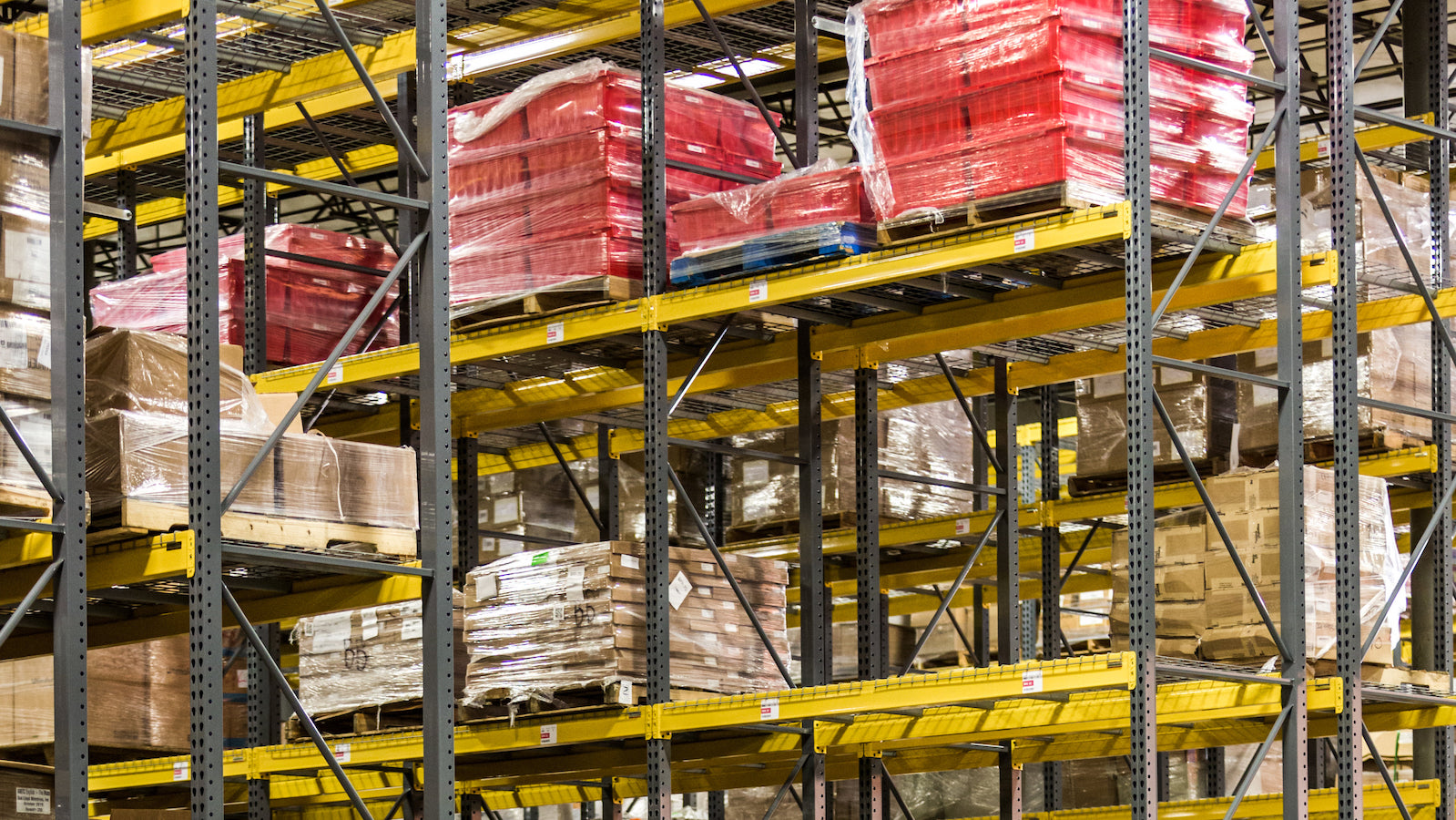Table of Contents
** Minutes
What is an inventory strategy?
5 inventory management strategies you can use today
How to develop your own inventory strategy
Common inventory strategy setbacks
ShipBob’s answer to inventory strategy setbacks
With inventory constantly moving throughout the supply chain, it can be a challenge to stay on top of it all — especially if you decide to sell on multiple channels or have inventory in different locations.
To manage inventory effectively, you need to have a solid inventory strategy in place to guide your efforts.
An inventory strategy can help you track stock consistently throughout your supply chain, so you have enough product at all times to be meet demand.
Let’s take a closer look at what an inventory strategy consists of, why it’s important, and what to consider when developing one of your own.
What is an inventory strategy?
An inventory strategy refers to having processes and systems in place to manage the flow of products throughout the supply chain chain, from manufacturing and procurement to warehousing and shipping.
Oversight of an inventory strategy helps ensure you have enough stock to meet demand while also optimising production, goods in transit, storage, and costs. It also helps your business stay organised with inventory accounting, so you’re prepared for tax season.
5 inventory management strategies you can use today
Managing inventory might seem simple at first, but it becomes more challenging as your SKU line, order volume, and customer base grows. Implementing the right inventory management strategies can help you save on costs, improve visibility, and prepare for the unexpected.
Here are some proven inventory management strategies you can start using today, which are easily achievable through technology.
1. Inventory management automation
Manual inventory management is not only time-consuming, but it’s also prone to errors. Inaccurate inventory records can throw your whole business for a loop as you could end up with major inventory discrepancies and unhappy customers.
Fortunately, there are plenty of inventory management automation systems available. Many of them are affordable and easy to implement into your existing ecommerce tech stack.
Inventory automation tools are designed to continuously track and manage your inventory across sales channels and distribution centres, so a business can maintain a high inventory turnover rate and low days sales in inventory.
2. Real-time inventory insights
Since inventory is constantly moving, being able to get real-time inventory insights is crucial. With real-time inventory insights, you can be quick to make decisions based on timely data.
That means you won’t have customers placing orders for out-of-stock items, because your inventory records weren’t up to date. In addition to preventing stockouts, it also reduces the risk of backorders, which can have a negative impact on customer satisfaction with long wait times.
Additionally, having accurate, real-time inventory insights helps your business establish a more agile supply chain. This way, in case something goes wrong, you can still fulfil orders on time.
3. Setting accurate reorder points
Along with real-time inventory tracking and automation, many solutions offer the ability to set automatic reorder points.
By looking at historical inventory data to forecast demand, you’re given insights into how many units you need to order and when. From there, you can set an automatic reorder point notification to easily stay on top of inventory replenishment.
There are a few other factors to consider when setting a reorder point, including production and warehouse receiving lead times (thinking through everything from transportation to 3PL turnarounds).
Make sure to evaluate first-mile delivery and inventory receiving timelines to ensure product is available on time to fulfil orders.
“ShipBob’s analytics tool is also really cool. It helps us a lot with planning inventory reorders, seeing when SKUs are going to run out, and we can even set up email notifications so that we’re alerted when a SKU has less than a certain quantity left. There is a lot of value in their technology.”
Oded Harth, CEO & Co-Founder of MDacne
4. Enabling safety stock inventory
You never know when there will be a sudden surge in demand. Maybe an influencer posted about your product, and suddenly you have thousands of people ordering that item.
Similarly, you may face inventory shortages if there are unexpected disruptions in the supply chain, such as:
- Dangerous weather events like flooding
- Holiday shutdowns like Chinese New Years
- General delays or facility closures from COVID outbreaks at manufacturing plants or fulfilment centres
This is why it’s crucial to keep a small amount of safety stock on hand (even at more than one location) to prepare for the unexpected. There’s a simple formula you can use to calculate how much safety stock you need:
Safety Stock = (Maximum daily usage x Maximum lead time) – (Average daily usage x Average lead time)
5. Accurate demand forecasting
Having an inventory strategy enables faster decision-making, which leads to adapting to changes in the market more quickly. The more accurate demand forecasting is, the better you can manage your inventory no matter what happens.
Of course, forecasting demand is never 100% accurate, but by anticipating how much demand you could have in the near future, you can plan ahead and either increase or decrease your inventory investment accordingly.
By combining inventory strategies like demand forecasting and safety stock, you can easily maintain optimal inventory levels to meet demand.
“ShipBob’s Inventory Planner integration allows us to have all of our warehouse forecasting and inventory numbers in one platform. We can create ShipBob WROs directly in Inventory Planner and have the inventory levels be reflected in our local shipping warehouse and ShipBob immediately.
It also provides forecasting for each individual ShipBob warehouse, so we know how many units we need to ship each week to cover a certain period and also to not run out of stock.”
Marc Fontanetta, Director of Operations at BAKblade
How to develop your own inventory strategy
There are several things to consider when developing your inventory strategy. Keeping your business needs in mind, here are some ways to develop an inventory strategy that leads to healthier profit margins, lower costs, and more satisfied customers.
Inventory scanning
If you run your own warehouse, barcode scanning should be a vital part of your inventory management process as it helps to keep things organised and maintain accurate inventory records. And if you work with a 3PL, providing barcoded products will only help them manage your inventory.
Inventory scanners can automatically read the information encoded in product barcodes and send that info to a warehouse management system. This makes it easy to:
- Track and manage SKUs in real time.
- Keep an eye on stock availability.
- Easily see where items are stored.
Inventory scanners can also help to enhance inventory visibility, especially when dealing with hundreds of SKUs. And, using inventory scanners can also greatly improve order accuracy and speed up the fulfilment process.
Inventory reporting
With the right systems and processes in place, not only can you easily manage inventory, but it’s much simpler to pull accurate inventory records when you have all the data at your fingertips.
Inventory reporting is crucial, because how your inventory is performing says a lot about your overall supply chain performance. And, since inventory is an asset, you will need accurate inventory reports for your accountant at the end of the year.
Inventory reporting may just seem like extra time or paperwork, but it can save you a ton of money and unnecessary effort down the road.
Inventory management
A critical aspect of your inventory strategy is inventory management, encompassing everything from SKU management to warehouse management.
Especially when it comes to managing multiple SKUs, you’ll need a strategy to keep track of and categorize your inventory at the SKU level to stay organised, improve order accuracy, and prevent stockouts.
Investing in inventory management software can help you streamline these efforts. Many 3PLs like ShipBob offer built-in inventory management tools to manage SKUs, track inventory days on hand, and provide real-time insights (and offer integrations with other systems, from inventory planning tools to ERP systems).
“Now we’re at two [ShipBob] fulfilment centres, and being able to have the analytics and see how everything is working together has been extremely helpful for me on the operations end. It definitely helps me with inventory management and seeing what’s going on. Even though we’ve grown, I haven’t spent more time on the business from an operations standpoint.”
Dana Varrone, Director of Operations at Organic Olivia
Inventory accounting
Inventory is a business asset, which means having accurate inventory records is crucial for inventory accounting purposes.
At the end of a financial year or accounting period, you will need to know how much your inventory is worth by choosing an inventory valuation method and sticking with it throughout the year.
Accurate inventory records take the guesswork out of defining inventory value. Instead of scrambling to pull accurate numbers, data can be automatically collected and downloaded. And many solutions make it easy to pull customisable reports.
Inventory forecasting
If there’s one thing every inventory strategy and plan should include, it’s having access to data and insights for inventory forecasting purposes.
Inventory forecasting is the process of figuring out how much inventory you will need to fulfil future orders based on how many units of each product you predict you will sell over a specific period of time.
When forecasting, you will have to consider planned promotions, the holiday shopping season, and other external events (e.g., when shoppers may be distracted during an election cycle or when shopper will be bored during a COVID lockdown).
You’ll also have to consider lead times (or how long it takes inventory to get from the manufacturer to the end point where it can be fulfiled) to ensure inventory is received on time to fulfil orders.
The right inventory management system can help you collect inventory analytics throughout your supply chain by connecting the upstream activities of purchasing and manufacturing to the downstream activities of sales and product demand.
Common inventory strategy setbacks
Ecommerce businesses come across a number of challenges when managing inventory. But an inventory strategy should solve for common challenges and setbacks. Here is an overview of the common inventory strategy setbacks and how to solve for them.
Inaccurate inventory counts
One major setback involves inaccurate inventory counts, which typically occur due to manual inventory processing. Regular inventory reconciliation is necessary to detect any discrepancies and get to the root of the problem.
To avoid inaccurate inventory counts, the best thing you can do is implement an inventory management system. In conjunction, using automated systems and inventory scanners can help to minimise the margin of error.
Also keep in mind that many ecommerce businesses often partner with a 3PL like ShipBob for access to built-in inventory management tools along with omnifulfilment solutions to easily stay on top of inventory control and quickly identify inaccuracies.
“I used to have to pull inventory numbers from three places everyday and move all the disparate data into a spreadsheet.
ShipBob has an analytics tab in their dashboard with all of this information, which is great for end-of-month reconciliations. It’s really nice to not have to operate three 3PLs.
For inventory planning, I love the SKU velocity report, daily average products sold, and knowing how much inventory we have left and how long it will last. The enhanced visibility is great.”
Wes Brown, Head of Operations at Black Claw LLC
SKU proliferation
As businesses scale and add more products to their catalogueueue, SKU proliferation can become a major problem if left unchecked (as you could soon run out of storage space and have your funds tied up in unsold inventory).
To avoid such issues when adding to your product line, it’s important to monitor fast-selling versus slow-moving items, as well as items that are at risk of going obsolete. Regular SKU rationalization (and lot tracking) may be necessary to keep proliferation in check and remove unprofitable SKUs from your ecommerce supply chain.
Dead stock and obsolete inventory
Most businesses will deal with dead stock or obsolete inventory at some point, but having too much unsellable inventory can really cost you.
As unsellable inventory builds up, it can take up valuable storage space and result in higher holding costs. Accumulating excess inventory is often caused by poor inventory forecasting and a lack of supply chain data.
To prevent unsellable inventory from building up, make sure you:
- Have an inventory management system in place.
- Perform regular inventory audits.
- Keep track of sales data for every SKU.
- Use lot tracking for products that have expiration dates or could be in a position that requires a recall.
If your business accumulates unsellable inventory, you have a few options. You can:
- Bundle product, combining both in-demand items with low-sale items (offering a discount).
- Offer bonus gifts to high spenders, giving away the unpopular product as a freebie or gift with purchases.
- Donate items to those who need them.
- Write off inventory at the end of the accounting period.
Stockouts
If you’re finding success but not restocking inventory fast enough, you could experience stockouts. Not only does this result in disappointed customers, but you’re also losing money. This is why accurate demand forecasting and real-time inventory tracking are crucial, so you can set reorder points and replenish your stock at the right time.
Additionally, having some buffer inventory is also essential to mitigating the impact of stockouts that result from unexpected demand surges and supply chain disruptions.
Effective catalogueueue management
One of the biggest challenges for ecommerce businesses is effective catalogueueue management. As you add or remove SKUs, you’ll need a process in place to keep your product database updated, accurate, and organised across all your sales channels and fulfilment or distribution centres.
This becomes particularly challenging when you’re dealing with a large selection of SKUs and selling through multiple channels.
It’s important to have an inventory management system that integrates with your online store, so all your inventory data is automatically updated in real time to provide the most accurate information.
ShipBob’s answer to inventory strategy setbacks
Outsourcing fulfilment to a 3PL like ShipBob may surprisingly be one of the keys to overcoming these major inventory strategy setbacks.
ShipBob provides you with an omnichannel fulfilment solution with built-in inventory tracking tools that make multichannel inventory management simple and less time-consuming.
Our growing, international fulfilment network uses a centralised warehouse management system, which provides accuracy, transparency, and full visibility into your inventory levels at all times, even down to the second an item is being picked.
With ShipBob, you can store inventory across fulfilment centre locations and sell on multiple channels while also keeping a close eye on stock levels in real time.
Additionally, ShipBob lets you track important inventory management KPIs by collecting real-time data on the inventory have on hand, SKU performance, and overall inventory status.


“ShipBob’s ability to service both D2C and B2B has enabled us to build more consistent procedures and practices across our different sales channels.
Along with Chewy, we’re also fulfiling orders through Amazon, as they are the two biggest online pet sales channels in the US.
We utilise ShipBob’s EDI solution that is connected to our 3rd party EDI platform SPS Commerce for our Chewy orders, and when we don’t ship directly to Amazon, we rely on ShipBob’s direct integration with Amazon for FBA orders.
We’re even exploring additional channels that ShipBob supports, such as Walmart.com.
Being an omnichannel brand is critical for us, so we can reach more pet lovers from more places. We’re glad that ShipBob helps us keep up with demand from all the places we reach our customers.”
– Stephanie Lee, COO at PetLab Co.
If you’re looking to improve your inventory strategy, ShipBob can help. Contact us to learn more about our omnichannel fulfilment solution and technology platform.
Improve inventory management with ShipBob’s WMS
For brands looking to store inventory and fulfil orders within their own warehouses, ShipBob’s warehouse management system (WMS) can provide better visibility and organisation.
Ecommerce merchants can now leverage ShipBob’s WMS (the same one that powers ShipBob’s global fulfilment network) to streamline in-house inventory management and fulfilment.
With real-time, location-specific inventory visibility, intelligent cycle counts, and built-in checks and balances, your team can improve inventory accuracy without sacrificing operational efficiency.
For brands looking to scale internationally, ShipBob even offers a hybrid solution where merchants can employ ShipBob’s WMS technology in their own warehouses while simultaneously leveraging ShipBob’s fulfilment services in any of ShipBob’s fulfilment centres across the US, Canada, Europe, and Australia to improve cross-border shipping, reduce costs, and speed up deliveries.
Inventory strategy FAQs
Here are answers to common questions about managing an inventory strategy.
What are the advantages and disadvantages of inventory strategy?
An inventory strategy helps manage stock more effectively, providing an outline for better inventory control and SKU tracking (i.e., knowing how many units you have of any product at any point in time). The main disadvantage is that it involves overcoming a few challenges along the way, which can be particularly overwhelming when you don’t have a digital inventory system in place. If you’re willing to invest in technology and commit to a few best practices, you can streamline this and have an improved inventory strategy.
What is the difference between inventory and inventory management?
Inventory refers to the products that you sell (from when they are created, to when they are in a warehouse, to when they are shipping to customers), where inventory management is the process of overseeing your stock across SKUs so that you can plan for future demand, optimise storage, and replenish it accordingly.
Can ShipBob help with an inventory strategy?
Yes, ShipBob simplifies your inventory strategy by storing your inventory for you and providing you with real-time inventory insights, historical performance data across every location, and features such as automatic reorder point notifications. For a more robust solution, ShipBob integrates with leading inventory management solutions and ERP systems, and offers an Inventory API for further customisation.



